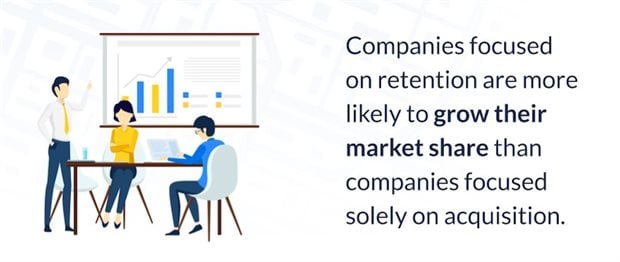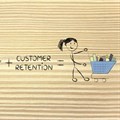5 ways to drive growth through customer retention

While I don’t doubt the importance of gaining new customers, be warned - plans that equate growth solely to acquisition won’t translate into a successful long term strategy.
So what will?
Retention.
Retention isn’t a new concept. What people really want today hasn’t actually changed much. They want great products and devices, convenience and value.
What has changed is our ability to provide what they want. A digital world means that what we lack without personal relationships with our customers, we make up with the help of data.
Every time a customer churns, stops using a certain feature or, on the flip side, recommends your product to others, they’re sending you signals which could help you improve your product or service. The next step is to pick up and decode these signals and use them to drive customer loyalty.
Just because you can’t wine and dine your top clients, doesn’t mean you can’t drive loyalty online. Here’s how:
Spend equal time focusing on retention and acquisition
Yes, you read that correctly.
While acquisition may seem like the be-all and end all goal, retention is actually much more important in the long run. Your retention metrics, including retention rate, NPS and churn, give you deeper insights into how many loyal customers your product is generating and how you could improve these numbers.
Not only does focusing on retention help you improve your product or service, it also improves your bottom line. Consider these findings:
● Acquiring a new customer is anywhere from five to 25 times more expensive than retaining an existing one.
● Research shows that a 5 % increase in customer retention correlates with at least a 25% increase in profit.
● 75 percent of loyal customers will recommend a brand to friends and family.
Activate your users
Determine what your product's ‘magic moment’ is. It’s that moment when your customer truly feels the value your product or service is bringing to their lives.
According to Alex Shultz, VP of growth at Facebook,
“You can go from 60% retention to 70% retention easily if you can connect people with what makes them stick on your site.”
Not all of your customers will reach that magic moment on their own. Sometimes you need to guide them to help get the best value out of your product.
To do this effectively you’ll need to start using data. Start by asking yourself:
● Which types of customers are more likely to stay?
● What actions did they take?
● Which features do they use most?
● In which context are they using your product?
Evolve your monetisation strategy
Your product’s pricing strategy should evolve based on shifts in the market, your target audience and the insights you gain from your customers. Achieving customer loyalty while also finding the right monetisation strategy is a delicate balancing act that requires testing and iteration.
This doesn’t necessarily mean you have to offer the most competitive prices if your business can’t afford it.
Walker predicts that by 2020 customer experience will overtake product and pricing as the key brand differentiator. Currently, 86% of consumers are willing to pay up to 25% more for a better customer experience.
Ultimately you need to pursue strategies that will help your business grow, without compromising your customer experience. Know what your brand stands for and deliver on this promise and make sure there are no obstacles blocking users from experiencing your ‘magic moment’.
Think long term
It’s not just about 'engaging with users' long term. You need to think about how you can get users to carry on engaging with you.
How can you generate long term value?
The more a user interacts with your product, the more data you can collect and builds up data, the more valuable it becomes. You can then use this data to provide even better value to loyal customers.
A great example is Spotify. It leverages customer data to create personalised “Discover Weekly” playlists. The more you use Spotify, the better its algorithms get at picking up your music preferences and using that to recommend new songs. This feature keeps bringing music enthusiasts back to their Spotify account week after week.
Reward your users
Introducing a rewards programme can be a great way to do this. Whether it’s as simple as buying 9 coffees to get the 10th free, or a more complex programme like using gamification to reward customers for their healthy lifestyle choices.
If you’re concerned that this will hurt your monetisation strategy, then consider this - 77% of customers are more likely to continue using a brand because of their loyalty programme.
Now don’t get me wrong, acquiring new customers is important, but this article is just a reminder that sustainable growth is a balance between acquisition and retention.























